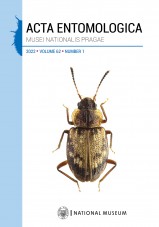Morphology of larvae and pupae of the genus Autocrates (Coleoptera: Trictenotomidae) and its phylogenetic implications
Cho Hee-Wook, Kwon Min Chul, Kim Sang Ki, Beutel Rolf G.
Acta Entomologica Musei Nationalis Pragae 62(1): 197-210, 2022
Published online: 25th October 2022
Views: 1467
Abstract: The trictenotomid genus Autocrates Thomson, 1860 is remarkable for its large
and robust adults, but its larval morphology and bionomics have been unknown
over the last 160 years. Here, we describe and illustrate in detail the eggs,
and also the first and last instar larva and the pupa of Autocrates maqueti
Drumont, 2006, based on specimens reared from identified adults collected in
South Korea. The first instar larva is very similar to the known trictenotomid
larvae of the genus Trictenotoma Gray, 1832, sharing the following features:
distinctly flattened and parallel-sided, well-sclerotized head and largely
unpigmented postcephalic body, lyre-shaped frontal arms, very short coronal
suture, five pairs of stemmata, asymmetrical and tridentate mandibles with mola,
simple and apically upturned urogomphi, and absence of longitudinal ridges on
the thorax and abdomen. Differences occur in the primary chaetotaxy. The last
instar larva is almost identical with Trictenotoma in general appearance, but
the longitudinal tergal ridges of Autocrates are much denser and more widely
distributed than those of Trictenotoma. Our preliminary assessment of features
of immature stages confirms a close relationship of Trictenotomidae with the
“salpingid group”, i.e. Salpingidae, Boridae, Pyrochroidae and Pythidae.
A sister group relationship with Pythidae is likely. The putative synapomorphy
is the subdivision of the ventral element of tergites IX, even though this
condition is not visible in the first instars of Autocrates, and quite
indistinct (but recognizable) in the last larval stage. The complete
mitochondrial genome of A. maqueti is provided. A preliminary phylogenetic
analysis of trictenotomid species is presented using two mitochondrial genes
(16S and COI). The morphology of eggs and biological information on feeding and
oviposition behaviors are also provided with photographs of adults and eggs.
Key words: Coleoptera, Tenebrionoidea, Trictenotoma, chaetotaxy, egg, immature stages, larva, morphology, phylogeny, Korea, Palaearctic Region
Papers
This issue is dedicated to Aleš SmetanaNew and little-known species of the genus Dicerapanorpa from northwestern Yunnan, China (Mecoptera: Panorpidae)A new Copelatus with small eyes from the Eastern Cape Wild Coast, South Africa (Coleoptera: Dytiscidae)Morphology of the larvae and biology of the adults of Psilorrhynchus bifasciatus do not confirm previous hypotheses about systematics and feeding habits (Coleoptera: Cantharidae)Review of the genera Elaphinis and Parelaphinis (Coleoptera: Scarabaeidae: Cetoniinae) with description of three new species from South AfricaThe ̒first fossil tumbling flower beetle’ larva is a symphytan (Hymenoptera)Revision of the genera of Picrotini (Coleoptera: Cryptophagidae: Cryptophaginae)First record of the genera Bulborhodopis and Mimapatelarthron from China, with description of one new species (Coleoptera: Cerambycidae)Two new species of the genus Omoplax (Hemiptera: Heteroptera: Tingidae) from Mukojima Island, with new records of lace bugs endemic to the Ogasawara Islands, JapanDiscovery of mysterious Pakistatyrus in Tibet (Coleoptera: Staphylinidae: Pselaphinae)Taxonomy of the intertidal athetine genus Eubadura stat. nov. (Coleoptera: Staphylinidae: Aleocharinae) from Japan, with descriptions of two new speciesTaxonomic notes on the Indian assassin bug Ectomocoris simulans (Hemiptera: Heteroptera: Reduviidae) with two new synonymsLeiodidae (Coleoptera) of the Hainan Island with new faunistic records from China and with notes on the unique body modifications in the genus AgathidiumA review of the genus Psammocrуptus (Coleoptera: Tenebrionidae: Tentyriini)Two new species of Xenos (Strepsiptera: Xenidae), parasites of social wasps of the genus Mischocyttarus (Hymenoptera: Vespidae) in the New WorldMorphology of larvae and pupae of the genus Autocrates (Coleoptera: Trictenotomidae) and its phylogenetic implicationsDrymini of Madagascar, with description of a new genus and three new species (Hemiptera: Heteroptera: Rhyparochromidae)Revision of Quedius sensu stricto (Coleoptera: Staphylinidae) 